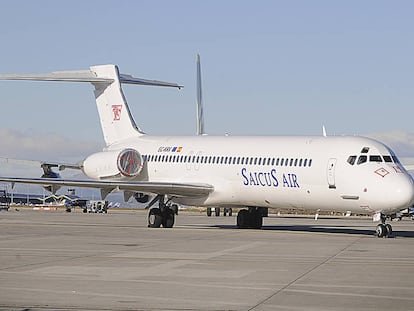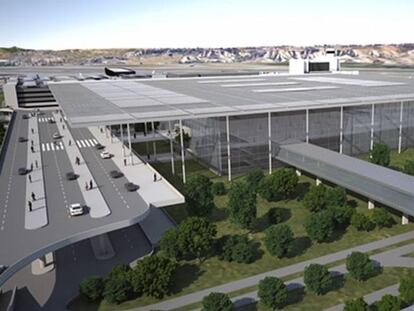Air Canada flight makes emergency landing in Madrid
The plane, with 128 passengers on board, had suffered damage to one of its wheels during takeoff

An Air Canada plane made an emergency landing at Adolfo Suárez-Madrid Barajas airport on Monday. The Boeing 767-300, with flight number AC837, had taken off from the Spanish capital at 2.30pm bound for Toronto with 128 passengers on board, but suffered damage to a wheel during takeoff. The situation was further complicated by an engine problem.
The plane was forced to circle over the Madrid region while burning off and dumping fuel before it could complete an emergency landing in the safest way possible, according to Spain’s air navigation authority ENAIRE.
The plane flying over Madrid to use up fuel.
According to passengers on board the aircraft, the atmosphere in the cabin was calm, thanks in part to the captain confirming that the situation was under control. “We are going to land at Barajas airport but the tanks are filled with fuel, so we are going to circle to spend some of the fuel so that we are lighter when we land,” he is reported to have said. “Everything is under control. This plane has eight wheels in the back and front landing carriage, and we have only lost one, so landing will not be a problem. Thank you for your patience.”
Given that the plane was scheduled to cross the Atlantic Ocean, it was carrying a full fuel load, which it had to lighten. An F-18 fighter aircraft was sent from an Air Force base in nearby Torrejón to evaluate the damage to the plane.
Drone incident
The emergency landing came after Madrid-Barajas airport was forced to close its airspace earlier on Monday due to the presence of unauthorized drones near the facility, Spain’s Transportation and Mobility Ministry confirmed.
The state air navigation authority ENAIRE was the first to indicate that the airport was experiencing delays. The Transportation and Mobility Ministry later confirmed that the airspace had been closed.
Flying drones near an airport is a serious violation and can lead to fines of up to €90,000Spain’s Air Security Agency
The decision to close the airspace was made just after 12.30pm on Monday after two pilots reported the presence of drones near the runways. This activated a process known as “Rate O,” which stops planes from landing and leaving the airport, according to sources from ENAIRE.
Flights scheduled to arrive in Barajas airport after 12.40pm were diverted to other airports, while all flights from the airport were suspended.
At 2.15pm, Spain’s AENA airport authority confirmed that 26 flights had been diverted – at least seven to Valencia, three to Barcelona, three to Zaragoza, and two to Alicante and Valladolid.
The Civil Guard sent officers to the scene to track down the individuals who flew the drones.
Regulation
The 2017 royal decree on the civilian use of drones states that they cannot be flown within eight kilometers of any airport or airfield, or within six kilometers of the furthest runway.
This limit can be altered if the drone owner has reached an agreement with airport management.
Failing to comply with this regulation can lead to serious sanctions. After the airspace shutdown, Spain’s Air Security Agency (AESA) said in a message on its official Twitter account that “flying drones near an airport is a serious violation and can lead to fines of up to €90,000.”
English version by Melissa Kitson.
Tu suscripción se está usando en otro dispositivo
¿Quieres añadir otro usuario a tu suscripción?
Si continúas leyendo en este dispositivo, no se podrá leer en el otro.
FlechaTu suscripción se está usando en otro dispositivo y solo puedes acceder a EL PAÍS desde un dispositivo a la vez.
Si quieres compartir tu cuenta, cambia tu suscripción a la modalidad Premium, así podrás añadir otro usuario. Cada uno accederá con su propia cuenta de email, lo que os permitirá personalizar vuestra experiencia en EL PAÍS.
¿Tienes una suscripción de empresa? Accede aquí para contratar más cuentas.
En el caso de no saber quién está usando tu cuenta, te recomendamos cambiar tu contraseña aquí.
Si decides continuar compartiendo tu cuenta, este mensaje se mostrará en tu dispositivo y en el de la otra persona que está usando tu cuenta de forma indefinida, afectando a tu experiencia de lectura. Puedes consultar aquí los términos y condiciones de la suscripción digital.
More information
Últimas noticias
Reinhard Genzel, Nobel laureate in physics: ‘One-minute videos will never give you the truth’
Pinochet’s victims grapple with José Antonio Kast’s rise in Chile
From digital curfews to blocking apps: How technology experts protect their children online
Why the price of coffee has skyrocketed: from Brazilian plantations to specialty coffee houses
Most viewed
- Pablo Escobar’s hippos: A serious environmental problem, 40 years on
- Why we lost the habit of sleeping in two segments and how that changed our sense of time
- Trump’s obsession with putting his name on everything is unprecedented in the United States
- The Florida Keys tourist paradise is besieged by immigration agents: ‘We’ve never seen anything like this’
- Charles Dubouloz, mountaineering star, retires at 36 with a farewell tour inspired by Walter Bonatti










































